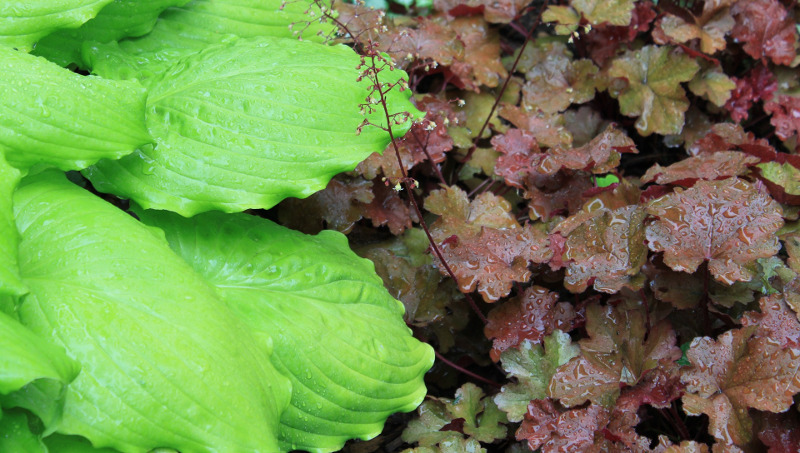If you want to add a vibrant burst of color to a shady corner of your garden or yard, then the Coral Bells or Heucheras may be for you. This cold-hardy perennial is native to North America and grows in USDA zones 4 through 9. The colorful foliage really makes this plant stand out, and in some regions, the plant will keep its foliage throughout the winter.
The large leaves can be heart-shaped or rounded, and many varieties feature ruffled edges. The foliage can be green, silver, gold, purple, burgundy, and more, depending on the type. Coral Bells bloom late spring through summer. Tiny, bell-shaped flowers grow in clusters and are known to attract hummingbirds.

What You Need To Plant Coral Bells
- Shovel
- Compost or manure
- Garden spade
- Water source
Where to Plant Coral Bells
Coral Bells need 4 to 6 hours of sunlight exposure each day, so the ideal spot will have partial shade but still get some light. When it comes to the soil requirements, Coral Bells need well-draining soil high in organic content, so mixing in compost or manure will help the plant thrive. Some varieties of Coral Bells prefer slightly acidic soil, but all types can do well in neutral soil.
Dig a hole about 18 inches deep and amend the soil with organic material when planting. Place the plant in the hole and position it, so the top of the root ball is even with the ground level and backfill the hole.
Coral Bells Spacing
Coral Bells can be used as a ground cover, and in a few years, the plant can spread out and quickly fill in a garden bed. Plant Coral Bells 18 to 24 inches apart from other plants like hostas and buildings, so the plants have room to grow. Coral Bells are not very fast growers, but they can steadily fill a space, and it is common for gardeners to thin them out after 3 or 4 years.

Steps To Plant Coral Bells
Where to plant Coral Bells is an important decision. The plant needs partial shade, and generally, 4 to 6 hours of sunlight is plenty. Too much sunlight exposure can scorch or burn the leaves, so avoid areas with lots of direct sunlight.
Dig a hole about twice the size of the root ball and 18 inches deep. Mix compost or fertilizer into the soil and position the plant so the top of the root ball is even with the ground level and fill in the hole. Spread mulch on the earth to retain moisture. The roots of Coral Bells may work their way above the soil's surface, so adding a layer of mulch will also help protect the roots.
Water the plant right away and plan to water your Coral Bells daily for the first week and every few days for the first growing season. Once the plant has settled in, you can water it about once a week. This plant has medium moisture requirements, so water when the top couple of inches of the soil is dry. Established plants can dry out somewhat, but Coral Bells will need help to get through a dry spell due to their shallow root system.
Step 1 - Select a good spot
Step 2 - Dig a hole twice as wide as the root ball and 18 inches deep
Step 3 - Mix organic matter into the soil
Step 4 - Place the plant, so the root ball is even with the ground and backfill the hole
Step 5 - Add mulch and water thoroughly
When to Plant Coral Bells
Spring is the best time to plant Coral Bells partly so you can enjoy the plant for an entire season but also because it will give the plant as much time as possible to settle in before winter. Coral Bells are cold hardy, but the more established the plant is, the better suited it will be to handle the cold. Coral Bells do not like hot temperatures, so try to plant during cooler times like early in the morning or later in the afternoon or evening. If planting in the morning, thoroughly drench the soil to protect against the warm temperatures to come.
Transplanting Coral Bells
Divide Coral Bells in the fall by digging up a plant and separating the root clumps. Usually, you can just use your hands to pull the sections apart gently. Replant each new plant 18 to 24 inches apart in areas that receive partial shade.Coral Bells can be grown from cuttings. You want to select sections from the crown of the plant with slight roots, which can be propagated in soil or water. It is usually best to start cuttings in the spring, so the new plants will be ready to be planted by the fall.
 |
Author Erica Browne Grivas - Published 12-14-2021 |
